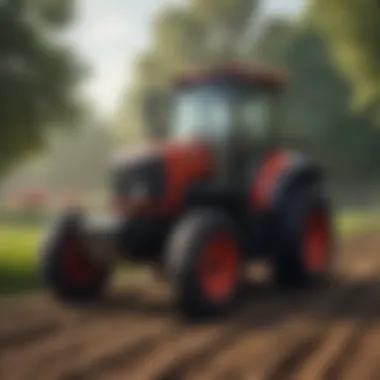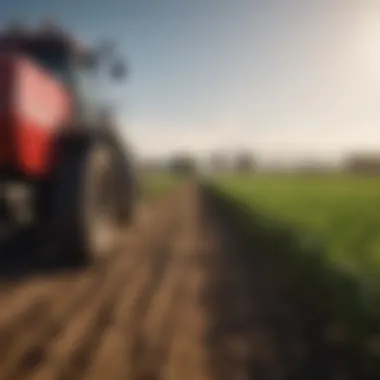Understanding REM Vac: Key Insights for Agriculture


Intro
In the realm of agricultural technology, REM vac emerges as a critical concept worth exploring in detail. Its role in improving farming practices and sustainability cannot be overstated. This overview seeks to dissect the many facets of REM vac, from fundamental definitions to emerging trends. Understanding REM vac is essential for farmers and enthusiasts aiming to increase productivity and efficiency in their agricultural endeavors.
Key Concepts and Terminology
Basic Definitions
REM vac, which stands for Reduced Emission Management Vacuum, encapsulates a variety of practices and technologies aimed at minimizing emissions during agricultural operations. This technique not only focuses on reducing the carbon footprint but also enhances the efficiency of various farming processes. Understanding the specific terminology associated with REM vac is crucial for effective communication among stakeholders within the agricultural sector.
Historical Context
The concept of REM vac has evolved over the years. Early adoption sought primarily to deal with environmental concerns associated with agriculture. Significant advances in technology over the last few decades have fostered its development. This historical perspective helps in appreciating the current state and future potential of REM vac.
Recent Innovations and Trends
Technological Advancements
In recent years, numerous technological innovations have emerged to augment the effectiveness of REM vac. This includes advanced sensor technologies that monitor emissions and soil health more accurately. These technologies allow farmers to receive real-time data, enabling them to make informed decisions.
Additionally, drone technology is increasingly being integrated into REM vac practices. Drones provide aerial assessments of farmland, ensuring a more thorough analysis of agricultural conditions.
Sustainable Practices
Sustainability is at the forefront of contemporary agricultural practices. REM vac aligns with sustainable farming by promoting reduced chemical use and enhancing biodiversity. The adoption of sustainable practices helps not only in reducing emissions but also in improving soil health and crop yields in the long term.
Practical Applications and Techniques
Step-by-step Guides
To fully implement REM vac in farming, there are several key steps:
- Assessment - Evaluate current farming practices and identify potential areas for improvement.
- Technology Integration - Incorporate relevant technologies such as sensors and drones.
- Training - Educate the team on the new practices and methodologies related to REM vac.
- Implementation - Execute the refined practices across diverse crop types and farming scenarios.
- Monitoring and Evaluation - Continuously monitor results to assess effectiveness and make necessary adjustments.
Case Studies
Several case studies highlight successful implementations of REM vac across different agricultural settings. For instance, a farm in California that adopted REM vac techniques reported a 30% reduction in greenhouse gas emissions along with an increase in overall crop yield. Such practical applications serve as real-world examples of how REM vac can positively influence agricultural productivity and sustainability.
"REM vac techniques have proven invaluable in reducing emissions while simultaneously boosting crop output."
Prolusion to REM Vac
Understanding REM Vac is crucial for agricultural advancements and sustainable farming practices. As challenges in food production and environmental sustainability arise, technologies like REM Vac emerge as viable solutions. They offer new methodologies for farmers seeking efficiency, increased yield, and reduced environmental impact.
REM Vac encapsulates a set of innovative methodologies designed to enhance agronomic practices. Its significance lies in its ability to bridge the gap between traditional farming methods and modern technological advances. Through the integration of REM Vac, farmers can achieve precision in farming practices, which translates to improved crop performance and resource management.
Key benefits of REM Vac include:
- Enhanced efficiency in agricultural processes.
- Sustainability through reduced resource usage.
- Cost-effectiveness that appeals to a wide range of agricultural operations.
Addressing REM Vac provides essential insights into its capacity to transform agriculture. Factors to consider include the technological requirements, training for implementation, and adaptability across different scales of farming operations. These considerations are vital for successful integration into existing practices.
Understanding these elements prepares the agricultural community for the evolving landscape of farming technology.
The journey of exploring REM Vac will begin with its formal definition and delve into the historical context that has shaped its development and application in agricultural systems.
The Science Behind REM Vac
The science of REM Vac is crucial for understanding how this innovative agricultural technology operates and the implications it has for modern farming practices. This section delves into its underlying principles and technicalities, shedding light on how REM Vac can enhance agricultural efficiency and sustainability. By exploring the mechanisms and technical specifications, we aim to provide a clear comprehension of the process that underpins REM Vac technology.'
Mechanisms of REM Vac
The mechanisms of REM Vac revolve around advanced vacuum and pressure dynamics that create optimal conditions for various agricultural applications. Essentially, this technology allows for efficient extraction and distribution of valuable resources such as nutrients, water, and even air. The primary principle is to manipulate atmospheric pressure to enhance plant health and growth.
This process usually involves specific tools designed to integrate seamlessly with existing agricultural equipment. The REM Vac system can achieve uniform application of water and nutrients throughout the soil, ensuring plants receive the exact amount they require. This targeted approach minimizes waste and maximizes yield.
Key components that enhance these mechanisms include:


- Vacuum Pumps: These are vital for generating the necessary pressure differences that facilitate the movement of substances within the soil.
- Control Systems: These systems monitor and adjust the application rates based on real-time data.
- Sensors: They provide critical information regarding soil moisture, nutrient levels, and plant health, enabling precision adjustments.
By leveraging these mechanisms, farmers can not only improve the efficiency of resource use but also promote sustainable agricultural practices that conserve water and reduce chemical inputs.
Technical Specifications
When considering the implementation of REM Vac technology, technical specifications play a significant role in determining its effectiveness. These specifications offer a detailed insight into the capabilities and operational requirements of the system.
Typically, the technical specifications of a REM Vac system might include:
- Power Supply Requirements: Most systems require robust electrical input to operate the vacuum pumps and control systems effectively.
- Airflow Rates: Specifications regarding the maximum and minimum airflow rates are critical for determining the technology’s ability to handle different soil types and plant sizes.
- System Compatibility: It is essential for the REM Vac system to be compatible with existing farming equipment, which may require adapters or specific configurations.
- Maintenance Protocols: Understanding the maintenance needs for optimal performance is also critical. Regular checks on vacuum pumps and sensors are required to ensure longevity and reliability.
By evaluating these technical specifications, farmers can make informed decisions regarding the adoption of REM Vac technology in their practices.
Emphasizing Efficiency: The right technical setup not only enhances performance but also significantly reduces operational costs in the long run.
Applications of REM Vac in Agriculture
The significance of Applications of REM Vac in Agriculture cannot be overstated. This segment explores how REM Vac technology is transforming agricultural practices. The alignment of technology with agricultural needs can address critical challenges in productivity, sustainability, and resource management. Effective use of REM Vac can lead to increased yields and optimized resource use, which is pivotal for modern farming.
Precision Farming
Precision farming is a breakthrough approach that leverages advanced technology for optimal agricultural output. With REM Vac, precision becomes more attainable. Remote sensing and data collection help farmers to understand field variability. This understanding enhances decision-making, allowing for responses tailored to field needs.
The benefits of precision farming with REM Vac include:
- Reduction of excess inputs, saving costs and resources.
- Enhanced crop performance due to targeted interventions.
- Data-driven insights that foster proactive management.
Farmers employing REM Vac can monitor conditions in real time. This dynamic adaptability ensures that crops receive precise amounts of water and nutrients. Hence, precision farming not only increases efficiency but also aligns well with sustainable practices by minimizing waste.
Soil Management
Effective soil management is essential for healthy crop growth. Implementing REM Vac technology facilitates deeper insights into soil conditions. This awareness helps manage soil health, improving fertility, and structure.
Key aspects of soil management with REM Vac encompass:
- Monitoring soil moisture levels optimally.
- Analyzing nutrient availability to support plant growth.
- Employing conservation techniques based on real-time data.
Farmers can make informed decisions about when and how to apply amendments, such as fertilizers or organic matter. The result is a healthier soil ecosystem, which is foundational for increasing biodiversity and resilience in agricultural landscapes.
Crop Monitoring
Crop monitoring is another crucial application of REM Vac. The ability to track crop health in real time can inform timely interventions. By utilizing satellite imagery and drone technology, potential issues can be identified quickly.
With REM Vac, crop monitoring involves:
- Evaluating plant health through various indicators.
- Recognizing symptoms of pests or diseases before they escalate.
- Facilitating timely harvesting based on data analytics.
Aspects such as yield prediction become easier with accurate crop data. This predictive capability allows farmers to optimize their harvest times and processes. Moreover, effective crop monitoring significantly contributes to quality control and market readiness.
"The integration of REM Vac technology in crop monitoring leads to better decision-making, resulting in improved yields."
In summation, the applications of REM Vac in agriculture provide substantial benefits across various functions. Precision farming, soil management, and crop monitoring offer essential insights that help farmers navigate the complexities of modern agriculture.
Benefits of Implementing REM Vac
Implementing REM Vac in agricultural practices comes with various advantages. Understanding these benefits can help farmers and agricultural enthusiasts appreciate its role in modern farming. This section explores specific benefits, emphasizing how they contribute to increased productivity and sustainability.
Increased Efficiency
One of the chief benefits of REM Vac technology is the significant increase in efficiency it offers to farming practices. By utilizing advanced mechanisms, REM Vac enables farmers to optimize their operations, reduce labor costs, and save time. For instance, precision farming techniques paired with REM Vac can assist in accurately applying inputs like fertilizers and pesticides. This targeted approach minimizes waste and maximizes yield potential.
Moreover, automation integrated within REM Vac systems aids in data collection and analysis, allowing farmers to monitor their fields in real-time. This results in faster decision-making processes, which is critical in addressing agricultural challenges promptly. The ability to monitor multiple parameters simultaneously means that farmers can adjust their strategies quickly, leading to better overall crop health and yield.
Sustainability Impacts
Sustainability is a key consideration in today's agricultural practices. The implementation of REM Vac contributes significantly toward sustainable farming by promoting resource conservation. For example, its precision application capabilities ensure that inputs are used efficiently, lowering the risk of runoff and minimizing environmental impact.
Additionally, many REM Vac systems are designed to work with renewable energy sources, further enhancing their sustainability aspects. Farmers can reduce their carbon footprint, aligning with global efforts to combat climate change. The technology can also help in preserving biodiversity by offering solutions that are environmentally friendly, thus supporting sustainable ecosystems in agricultural settings.


"Adopting REM Vac is not just about efficiency; it is a step towards sustainable farming practices that prioritize the health of our planet."
Cost-Effectiveness
From a financial perspective, the cost-effectiveness of REM Vac cannot be overlooked. Although initial investment costs might seem significant, the long-term savings considerably outweigh these expenses. By enhancing efficiency and promoting sustainable practices, farmers can reduce their overall costs on inputs such as water, fertilizers, and labor.
Moreover, the ability to increase crop yields effectively translates to improved profits. Farmers who use REM Vac technologies can expect a higher return on investment due to above-average productivity.
In summary, the benefits of implementing REM Vac are profound. Increased efficiency, positive sustainability impacts, and cost-effectiveness collectively redefine modern farming practices. Understanding these elements is essential for all stakeholders in the agricultural field.
Challenges in Adoption of REM Vac
The concept of REM Vac, while promising for agricultural innovations, faces several barriers that may inhibit its widespread implementation. Understanding these challenges is vital for stakeholders who wish to explore efficient agricultural practices. Addressing these obstacles can assist farmers, technology providers, and policymakers in devising strategies that facilitate a smoother transition to REM Vac utilization.
Technical Barriers
A significant hurdle in adopting REM Vac technology stems from the technical complexities involved. Many agricultural sectors still rely on traditional methods, and integrating new systems can be daunting. Not all farmers have access to the necessary infrastructure or knowledge to operate advanced technologies. This gap often results in a dependency on outdated techniques due to an inability to adapt. Training programs can help alleviate this issue, but they require time, effort, and resources. Moreover, the variability of agricultural environments can complicate the implementation of REM Vac systems, as solutions may need customization for specific local conditions.
Financial Constraints
Financial limits significantly impact the adoption of REM Vac technology. Many farmers face tight budgets and may perceive the initial costs of implementing this technology as a risky investment. The costs associated with acquiring new equipment, training personnel, and maintaining systems can deter potential adopters. Additionally, small and medium-sized farms are often more vulnerable to market fluctuations, further complicating their ability to make such investments. Access to financing options and grants can be essential to diminish these financial burdens. Programs that offer financial assistance to farmers willing to adopt REM Vac technologies could facilitate a broader acceptance of these innovations.
Resistance to Change
Cultural and psychological factors also play a crucial role in the challenges faced by REM Vac adoption. Many farmers have established practices that have worked for them over the years, creating a natural resistance to change. A perception that new technologies threaten their autonomy or that they might not yield better results can hinder any transition process. This status quo bias often underscores traditional farming methodologies, making it necessary for advocates of REM Vac to build trust among farmers by demonstrating the clear benefits and success stories associated with its implementation. Education and engagement are key to overturning these attitudes and fostering a more receptive mindset toward innovative practices.
"The path to integrating new technologies in agriculture requires more than just tools; it necessitates a change in mindset and supportive frameworks."
As REM Vac continues to emerge in the agricultural landscape, a concerted effort in addressing these challenges through education, financial support, and technological training can enhance its adoption and effectiveness.
Future Trends in REM Vac Technology
The realm of agriculture is continuously evolving, and with it, the technologies that underpin modern farming practices. Understanding Future Trends in REM Vac Technology is essential for stakeholders within the agricultural sector. This section delves into how emerging trends can reshape the landscape of farming, enhancing both productivity and sustainability. As agricultural challenges become more complex, innovations in REM Vac technology seem critical to delivering effective solutions.
Innovative Developments
Recent advancements in technology have spawned several innovative developments in REM Vac systems. These innovations focus on improving efficiency, accuracy, and ease of use. Some key areas of development include:
- Sensor Technology: Integration of advanced sensors has greatly improved the data gathering capabilities of REM Vac systems. This technology allows for real-time monitoring of soil conditions, moisture levels, and crop health.
- Robotics and Automation: Robotics are being increasingly employed to automate tasks such as planting, fertilizing, and harvesting. This evolution in automation minimizes human error and enhances productivity.
- Drones and Aerial Imaging: The use of drones equipped with cameras and sensors for aerial imaging is becoming commonplace. This facilitates precise mapping of fields, enabling farmers to apply targeted treatments where needed.
- Soil Health Monitoring: The ability to assess soil health and nutrient levels through innovative testing methods streamlines soil management processes. This leads to better cultivation practices and higher yields.
These innovative developments are not only driving efficiency but also helping to address critical agricultural challenges, such as climate change and food security.
Integration with AI and Data Analytics
The integration of Artificial Intelligence (AI) and data analytics into REM Vac technology is fundamentally transforming agricultural practices. This synergy offers significant advantages for farmers who are keen on adopting modern techniques. Consider the following aspects:
- Predictive Analytics: By utilizing data from previous harvests, weather patterns, and soil conditions, AI algorithms can predict future agricultural outcomes. This allows for better planning and resource allocation.
- Customized Solutions: AI can help create tailored recommendations for farmers based on specific conditions and historical data, optimizing the use of resources and enhancing crop yields.
- Enhanced Decision-Making: With real-time data analysis, farmers can make informed decisions on the fly. This agility can significantly reduce waste and improve the effectiveness of agricultural practices.
- Risk Management: AI and data analytics facilitate better risk assessment, equipping farmers with tools to navigate uncertainties associated with changing weather conditions and market fluctuations.
In summary, the convergence of innovative developments and AI in REM Vac technology is paving the way for a more efficient, data-driven approach to agriculture. By keeping abreast of these trends, farmers can position themselves to harness the full potential of REM Vac systems.
Case Studies on REM Vac Implementation
Case studies play a crucial role in understanding the practical implications and real-world applications of REM Vac in agriculture. They provide tangible examples of how this technology can enhance farming practices, and highlight both successes and challenges. Through these case studies, farmers and practitioners can glean insights on best practices, innovative strategies, and potential pitfalls.
Successful Agricultural Projects
In various regions, REM Vac has been successfully implemented. An example is the use of REM Vac technology in precision farming across Iowa. Here, farmers utilized REM Vac devices to optimize irrigation systems. The result was an increase in crop yields by 20% while consuming 30% less water compared to traditional methods. This case not only showcases the efficiency of REM Vac but also illustrates how it contributes to sustainable water management.
Another noteworthy project took place in California. Here, a collective of farmers adopted REM Vac for soil health monitoring. The system provided real-time data on soil conditions, allowing farmers to make informed decisions regarding fertilizer application. This led to a reduction in chemical use by 15% and overall costs by 10%, demonstrating the economic benefits of REM Vac implementation.
Lessons Learned from Failures
Despite the advantages, some REM Vac implementations have faced challenges. A case study in Nebraska revealed that an improper initial assessment of soil characteristics led to inadequate data collection. As a result, the farmer experienced crop losses due to mismanagement of soil resources. This example highlights the importance of conducting thorough assessments before deploying REM Vac technology.
Furthermore, in a project in Texas, resistance from farmers to embrace new technology hampered the adoption of REM Vac tools. The project struggled due to lack of training and support, resulting in low engagement and minimal improvements in agricultural practices. This case underscores the need for comprehensive training programs to ensure farmers feel comfortable and confident in using new technologies.
"Understanding the experiences of others is essential for successful implementation of REM Vac in agriculture."


Culmination
Each case study, whether successful or revealing failures, provides valuable lessons for the agriculture community. They emphasize the need for proper planning, thorough assessment, and ongoing support in the deployment of REM Vac technology. As farmers look to adopt innovative solutions, these case studies serve as a guide to navigate the complexities of modern agricultural practices.
Assessment and Evaluation of REM Vac Performance
The assessment and evaluation of REM Vac performance holds significant relevance in understanding how effectively this technology can be integrated into agricultural practices. Performance evaluation allows farmers and industry stakeholders to measure the impacts of REM Vac systems on crop yields, resource use efficiency, and overall productivity. A rigorous assessment not only highlights the strengths and advantages of REM Vac but also identifies any limitations or areas needing improvement. This information is vital in making informed decisions about investment, implementation, and potential scaling of technology in various agricultural settings.
Performance Metrics
Performance metrics are critical in quantifying the effectiveness of REM Vac systems. These metrics help farmers to track progress and make data-driven decisions. Some of the essential metrics to consider include:
- Yield Improvement: The increase in crop yields following the implementation of REM Vac, compared to traditional methods.
- Resource Utilization: Measures how efficiently water, fertilizers, and other inputs are used, reflecting sustainability.
- Cost Savings: Evaluates reductions in operational costs through enhanced efficiency.
- Time Efficiency: Assesses how the technology impacts labor and time spent on farming tasks.
By employing these metrics, farmers can create a clearer picture of how REM Vac influences their farming practices and outcomes.
Feedback from Practitioners
Understanding the experiences of those who have used REM Vac is essential for gauging its practicality and effectiveness. Feedback from practitioners offers insights that are often not captured in formal studies. Some key points include:
- Ease of Use: Many users report on the intuitiveness of REM Vac systems, affecting their adoption rate.
- Satisfaction with Results: Positive testimonials often highlight increased productivity and profitability, indicating successful implementation.
- Technical Support Experience: Users may share their experiences with customer service and technical assistance, which can influence future users' decisions.
- Challenges Encountered: Feedback often reveals obstacles faced during implementation, such as initial setup difficulties or integration with existing systems.
Gathering such feedback ensures a comprehensive understanding of REM Vac, enabling continuous refinement of the technology to better meet the needs of farmers.
Regulatory Aspects of REM Vac Usage
The regulatory landscape surrounding REM Vac is crucial for its effective implementation in agriculture. Regulations can greatly influence the success of this technology. Understanding the specifics of these rules helps farmers comply and maximize the technology’s benefits.
Industry guidelines and regulations are designed to ensure safety, efficacy, and fair market practices. Farmers and agricultural businesses must stay informed about these standards to avoid potential risks, both legal and operational. Regulatory requirements also provide a framework for the evaluation of REM Vac. Properly followed regulations enable an environment that fosters innovation while ensuring the protection of public health and the environment.
Compliance Requirements
Compliance with regulations involves adhering to local, state, and federal guidelines related to agricultural practices. Specifically for REM Vac, farmers must be aware of several key aspects:
- Certification Standards: Using REM Vac often requires certification to ensure equipment meets safety and efficiency norms.
- Documentation: Keeping thorough records of all farming operations using REM Vac is essential. Documentation can include data on applications, outcomes, and adjustments made during use.
- Training: Appropriate training for personnel who operate REM Vac systems is a requirement in many regions.
- Environmental Impact Assessments: Farmers may be required to conduct assessments to evaluate how REM Vac affects surrounding ecosystems. This may include effects on soil quality, water resources, and biodiversity.
These compliance requirements collectively aim to safeguard farming operations and promote responsible use of technology in agriculture.
Impact of Policies on Adoption Rates
The policies governing REM Vac have a significant impact on how quickly farmers adopt this technology. They can either motivate or hinder adoption based on incentives or restrictions put in place. Key factors include:
- Incentives: Policies that provide financial aid or tax breaks for using REM Vac can enhance adoption rates. Farmers are more likely to invest in technology if there is a clear financial benefit.
- Availability of Resources: Government-backed resources such as training programs or informational workshops can drive understanding and confidence in using REM Vac systems.
- Restrictions: Conversely, overly stringent regulations may deter farmers from integrating REM Vac. They may perceive the technology as complicated or costly if the compliance burdens are too high.
Overall, the regulatory landscape shapes how farmers view REM Vac and influences their willingness to adopt advanced practices. Effective policies that balance innovation with safety contribute significantly to the future of agriculture.
Culmination and Implications of REM Vac in the Future of Agriculture
The exploration of REM Vac reveals not only its technical foundations and applications but also its potential to redefine the landscape of modern agriculture. As we conclude this overview, it is vital to reflect on the significance of REM Vac technologies and their broader implications for the agricultural sector.
Importance of REM Vac in Agriculture
Firstly, adoption of REM Vac contributes to enhanced agricultural productivity. Farmers today face pressure to produce more while utilizing fewer resources. By implementing REM Vac technologies, farms can optimize inputs, improve crop yields, and ensure efficient resource management.
Furthermore, the environmental benefits are substantial. The shift towards precision in farming, made possible through REM Vac, promotes sustainability. This technology facilitates more judicious use of water, fertilizers, and pesticides, which leads to decreased waste and reduced ecological footprints.
Economic Considerations
The economic implications of integrating REM Vac into farming practices are promising.
- Cost Savings: Farmers experience lower operational costs. Efficient use of resources translates to reduced expenditure on inputs.
- Market Competitiveness: Moreover, REM Vac can enhance the market position of farmers by improving product quality and consistency, making their produce more desirable in competitive markets.
These elements underline not just the feasibility of REM Vac systems but also their attractiveness to a wide range of stakeholders—from individual farmers to large agribusiness operations.
Technological Advancements and Future Prospects
Another important aspect to consider is how REM Vac technology continues to evolve. As research and development progresses,
- Integration with Emerging Technologies: The combination of REM Vac with Artificial Intelligence and data analytics will likely reshape agricultural strategies and forecasting, optimizing decision-making processes.
- Scalability: Furthermore, the scalability of these systems can support various farm sizes, allowing smallholders to benefit from advancements that were once the domain of large-scale farms.
By considering the implications of REM Vac, we understand it not just as a tool but as a pivotal force in reimagining agriculture's future.
Final Thoughts
In summary, the future of agriculture without REM Vac presents significant challenges and limitations. Conversely, its integration offers opportunities for growth, sustainability, and resilience. As farmers and agricultural enthusiasts begin to embrace these technologies, they pave the way for a new era of farming—one that is more efficient, environmentally friendly, and capable of meeting the world’s food security needs. The importance of REM Vac cannot be overstated as we move forward into a more demanding agricultural landscape.















